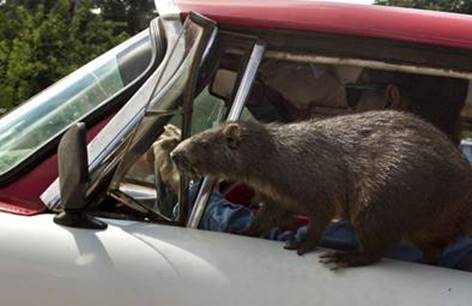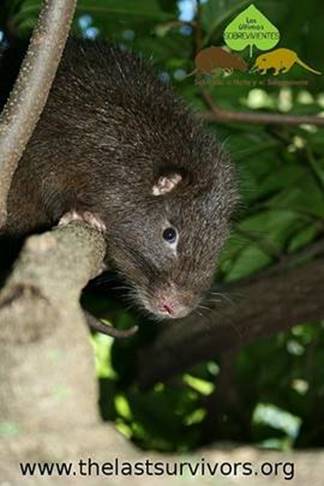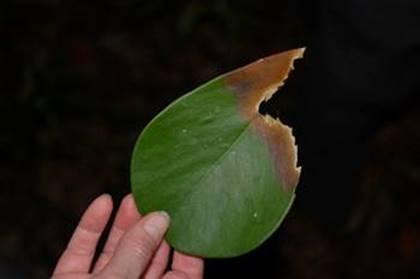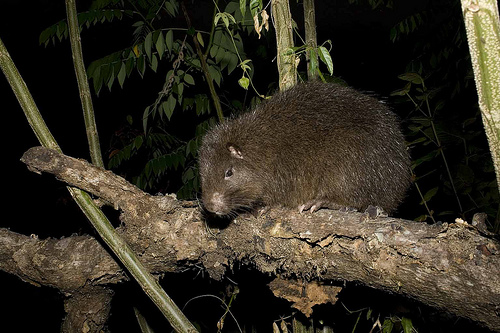In return the Indians would receive two glass beads for every loaf of cassava bread they supplied; two lace points for two hutia, the large rodents Christopher’s crew had eaten on Colba during his second voyage; maize, or other items they supplied. –Christopher Columbus Across the Ocean, Janet and Geoff Benge.
This is one of the several hutias that inhabited the island of Hispaniola (Haiti and Dominican Republic) at some time – the Hispaniola hutia (hu-TE-a) is the only confirmed extant species of the genus on the DR, though there is some debate about the taxonomy of others on the island, but for now they are considered a subspecies. Another five species are known from kitchen midden remains and persisted on the island until the 17th century.
The Hispaniola hutia was first described in 1836 by Frederic Cuvier and was considered rare at that time. Cuvier was the head keeper of the menagerie at the Museum d’Historie Naturelle in Paris and has the distinction of being mentioned in both Darwin’s On the Origin Species and Melville’s Moby-Dick. The species was widely thought to have gone extinct until the mid-20th century. Recent countrywide surveys by The Last Survivors Project have shown that is far more widely distributed across the Dominican Republic than previously thought.
Plagiodontia – Greek plagios– placed sideways, and odous – tooth, or oblique tooth. Aedium –place with a hearth, or room. The genus name refers to the dentition pattern – not clear what the species name refers to.
These are small mammals with a 12-inch long body and another 6 inches of tail. They tip the scales at about 45 ounces. The tail is scaly with little hair and the body is covered with dense brownish or grayish hair on the dorsal side with buffy underparts. Each foot has five toes with a claw, except the thumb, which has a short, blunt nail.
Not much is known about their breeding but they are thought to bear one or two young per litter. Uncommon to most rodents, the young are precocial, ready to run around shortly after birth – compared to most rodents, which are altricial and born with eyes shut and hairless. Hutia have lived almost 10 years in captivity. Individuals communicate with soft, bird-like chirping noises.
I did not see this in the DR but in Cuba some folks keep hutia as pets!

The main threat to their existence is land clearing, primarily for agriculture, which is prevalent in adjacent Haiti and hutia populations there are depressed. The species seems to be holding their own in the Dominican Republic because of protected areas and less widespread forest removal. There is little hunting of the species and some predation by free-roaming village dogs. Hutia also seem a bit flexible in habitat preferences and are more abundant in degraded habitats than the more picky Hispaniola solenodon. Hutia prefer undisturbed primary forest on the island, however.
Hutia inhabit forests on Hispaniola, typically along steep hillslopes and along ravines from sea level up to elevations of 5,000 feet. Typically, they live in burrows and in the evening they leave these to climb trees to feed on leaves. Some hutia have been found to nest in tree trunks.
Several years ago I spent a couple weeks in the DR and was lucky enough hook up with Jorge Brocca, who runs the Dominican Ornithological Society and works with the Last Survivors Project, among other entities. We drove several hours west of Santa Domingo to the town of Pedernales along the border with Haiti to bird watch and find the hutia and solenodon.
After a successful evening catching a couple solenodon we moved on to look for hutia the next evening. We picked up Niccole, Jorge’s field assistance for many projects who grew up in the area and was catching critters since he was a kid. We drove into the mountains for about an hour and down a steep dirt road to a flat area. We were surrounded by steep hillslopes and ravines of karst topography – limestone dominated bedrock.

We got out of the car to look around and Niccole and Jorge chatted a bit in Spanish and then came over to me and Connie. Well, we got here faster than we thought and it has to be really dark before the hutia come out of their burrows, so we could just hang here or we could go get some good coffee.
Coffee? Where? We hadn’t passed anything that could be remotely considered a village since we left town. We looked at each other. “Ok, coffee. Why not?”
Back into the truck and we drove up the steep grade and along the road for about 20 minutes and hung a left on a small road and found two small shacks nestled in the forest. We stopped and got out and Niccole introduced us to an elderly couple that were friends. It was just getting dark and we sat outside behind the house. The woman went into the small kitchen with a headlamp and started brewing while the gentleman showed me around his garden – he spoke slowly for my sake.
His wife came out and we sat around in the dark chatting and drinking their rich coffee. At one pause in the conversation the husband pointed behind me for the source of his coffee beans, several coffee plants. Eventually the Spanish conversation picked up speed and I was lost. We soon said our thanks and were back in the truck and to our previously scouted area for the hunt.
We walked up the hillslope, zig-zagging along limestone benches and slowed down near the top. Niccole and Jorge scanned the ground and stopped and listened, and then moved along. Scanning the ground with his headlamp Niccole found what he was looking for – a chewed up leaf indicating hutia foraging. We stood silent for a bit and then heard some rustling above us. Eventually we found some hutia munching on leaves about 20 feet up the trees. Up a Tree

These hutia live in the crevices of the landscape bedrock, creeping out at night to forage in the nearby tree canopy. Niccole said
“You need to listen for them eating – and pooping” – their small scat hitting the dry leaves on the forest floor. After a beer in town we went back to hotel for a well-deserved sleep. And of course, the coffee kept me up for a bit while I replayed the hutia dancing in the trees.
